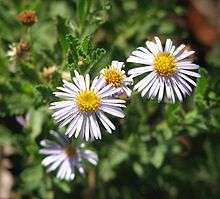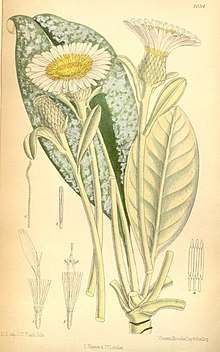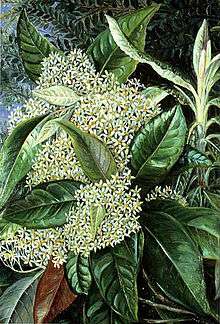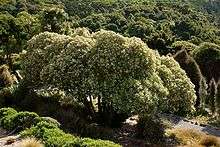Olearia
Olearia, most commonly known as daisy-bush,[2] is a genus of flowering plants belonging to the family Asteraceae, the largest of the flowering plant families in the world. Olearia are found in Australia, New Guinea and New Zealand. The genus includes herbaceous plants, shrubs and small trees. The latter are unusual among the Asteraceae and are called tree daisies in New Zealand. All bear the familiar daisy-like composite flowerheads in white, pink, mauve or purple.
| Olearia | |
|---|---|
 | |
| Olearia stuartii | |
| Scientific classification | |
| Kingdom: | Plantae |
| Clade: | Tracheophytes |
| Clade: | Angiosperms |
| Clade: | Eudicots |
| Clade: | Asterids |
| Order: | Asterales |
| Family: | Asteraceae |
| Tribe: | Astereae |
| Genus: | Olearia Moench[1] |
| Type species | |
| Olearia tomentosa | |
| Species | |
|
See text. | |
Description
Plants in the genus Olearia are small or large woody shrubs characterised by a composite flower head arrangement with single-row ray florets enclosed by small overlapping bracts arranged in rows. The flower petals are more or less equal in length. The centre of the bi-sexual floret is disc shaped and may be white, yellowish or purplish, generally with 5 lobes. Flower heads may be single or clusters in leaf axils or at the apex of branchlets. Leaves may be smooth, glandular or with a sticky secretion. The leaves may grow opposite, alternate, arranged sparsely or clustered. Leaf margins either entire or lobed, with or without a stalk. The fruit are dry slightly compressed, one-seeded, narrow-elliptic or egg-shaped with longitudinal ridges and smooth or with sparse hairs.[3][4][5]
Taxonomy and naming
The genus is named after Johann Gottfried Olearius, a 17th-century German scholar and author of Specimen Florae Hallensis.[6] Originally a large genus, a molecular study has found it to be polyphyletic.[7] Olearia species are used as food plants by the larvae of some Lepidoptera species including Aenetus ligniveren, which burrows into the trunk.
Distribution
There are approximately 180 species of Olearia, of which about 112 species are endemic to Australia. Olearia are found in all states of Australia.[5]
Species

The following is a list of Olearia species accepted by the Australian Plant Census or the New Zealand Plant Conservation Network or listed in the Census of Vascular Plants of Papua New Guinea as at April 2019:[8][9][10]
- Olearia adenocarpa (N.Z.)
- Olearia adenolasia
- Olearia adenophora
- Olearia aglossa
- Olearia albida (N.Z.) – tanguru
- Olearia algida - alpine daisy-bush
- Olearia allomii (N.Z.)
- Olearia alpicola
- Olearia angulata (N.Z.)
- Olearia angustifolia (N.Z.)
- Olearia arborea (P.N.G.)
- Olearia arborescens (N.Z.) – common tree daisy
- Olearia archeri
- Olearia arckaringensis
- Olearia argophylla - musk daisy-bush, native musk, silver shrub
- Olearia arguta
- Olearia arida
- Olearia asterotricha - rough daisy-bush
- Olearia astroloba - marble daisy-bush
- Olearia avicenniifolia (N.Z.) – Akeake
- Olearia axillaris - coast daisy-bush
- Olearia ballii - mountain daisy
- Olearia brachyphylla
- Olearia brevipedunculata
- Olearia bullata (N.Z.)
- Olearia burgessii
- Olearia calcarea
- Olearia canescens - grey daisy-bush
- Olearia capillaris
- Olearia cassiniae
- Olearia chathamica (N.Z.)
- Olearia cheesmanii (N.Z.) – streamside tree daisy
- Olearia chrysophylla
- Olearia ciliata - fringed daisy-bush
- Olearia colensoi (N.Z.)
- Olearia cordata
- Olearia covenyi
- Olearia coriacea (N.Z.)
- Olearia crebra (N.Z.)
- Olearia crosby-smithiana (N.Z.)
- Olearia cuneifolia
- Olearia cydoniifolia
- Olearia cymbifolia (N.Z.)
- Olearia decurrens - clammy daisy-bush
- Olearia divisolia (P.N.G.)
- Olearia durifolia (P.N.G.)
- Olearia elaeophila
- Olearia elliptica - sticky daisy-bush
- Olearia eremaea
- Olearia ericoides
- Olearia erubescens - pink-tip daisy-bush, moth daisy-bush
- Olearia exiguifolia
- Olearia ferresii
- Olearia fimbriata (N.Z.)
- Olearia floccosa (P.N.G.)
- Olearia flocktoniae - Dorrigo daisy-bush
- Olearia floribunda - heath daisy-bush
- Olearia fluvialis
- Olearia fragrantissima (N.Z.)
- Olearia frostii - Bogong daisy-bush
- Olearia furfuracea (N.Z.) - akepiro
- Olearia gardneri (N.Z.)
- Olearia glandulosa - swamp daisy-bush
- Olearia glutinosa - sticky daisy-bush
- Olearia gordonii
- Olearia grandiflora
- Olearia gravis
- Olearia hectorii (N.Z.)
- Olearia heterocarpa
- Olearia heterolepis (P.N.G.)
- Olearia heterotricha (P.N.G.)
- Olearia homolepis
- Olearia hooglandii (P.N.G.)
- Olearia hookeri
- Olearia humilis
- Olearia hygrophila
- Olearia ilicifolia (N.Z.)– hakeke
- Olearia imbricata
- Olearia incana
- Olearia incondita
- Olearia iodochroa - violet daisy-bush
- Olearia kenrotii (P.N.G.)
- Olearia laciniifolia
- Olearia lacunosa (N.Z.) - lancewood tree daisy
- Olearia lanata (P.N.G.)
- Olearia lanuginosa
- Olearia lasiophylla
- Olearia laxiflora (N.Z.)
- Olearia ledifolia
- Olearia lehmanniana
- Olearia lepidophylla - club-moss daisy-bush
- Olearia lepidota (P.N.G.)
- Olearia leptocephala (P.N.G.)
- Olearia liniata (N.Z.)
- Olearia lirata - snowy daisy-bush
- Olearia lyallii (N.Z.)
- Olearia macdonnellensis
- Olearia magniflora - splendid daisy-bush
- Olearia megalophylla - large-leaf daisy-bush
- Olearia microdisca
- Olearia microphylla - small-leaf daisy-bush
- Olearia minor
- Olearia montana
- Olearia monticola (P.N.G.)
- Olearia mooneyi
- Olearia moschata (N.Z.)
- Olearia mucronata
- Olearia muelleri
- Olearia muricata
- Olearia myrsinoides - blush daisy-bush, silky daisy-bush
- Olearia nernstii
- Olearia newbeyi
- Olearia nummulariifolia (N.Z.)
- Olearia obcordata
- Olearia occidentissima
- Olearia odorata (N.Z.) - scented tree daisy
- Olearia oliganthema
- Olearia oporina (N.Z.)
- Olearia oppositifolia
- Olearia orientalis
- Olearia pachycephala (P.N.G.)
- Olearia pachyphylla (N.Z.)
- Olearia pallida (P.N.G.)
- Olearia paniculata (N.Z.) - akiraho
- Olearia pannosa - velvet daisy-bush
- Olearia passerinoides
- Olearia paucidentata
- Olearia persoonioides
- Olearia phlogopappa - dusty daisy-bush
- Olearia picridifolia
- Olearia pimeleoides - pimelea daisy-bush
- Olearia pinifolia
- Olearia platyphylla (P.N.G.)
- Olearia plucheacea
- Olearia polita (N.Z.)
- Olearia quercifolia – oak-leaved daisy-bush
- Olearia quinquevulnera (N.Z.)
- Olearia racemosa
- Olearia ramosissima
- Olearia ramulosa - twiggy daisy-bush
- Olearia rani (N.Z.) – heketara
- Olearia revoluta
- Olearia rosmarinifolia
- Olearia rudis
- Olearia rufa (P.N.G.)
- Olearia rugosa
- Olearia semidentata (N.Z.)
- Olearia solandri (N.Z.) - coastal tree daisy
- Olearia speciosa (N.Z.) - netted daisy-bush
- Olearia spectabilis (P.N.G.)
- Olearia stellulata
- Olearia stenophylla
- Olearia stilwelliae
- Olearia strigosa
- Olearia stuartii
- Olearia subspicata
- Olearia suffruticosa - clustered daisy-bush
- Olearia tasmanica
- Olearia telmatica (N.Z.)
- Olearia tenuifolia
- Olearia teretifolia - cypress daisy-bush
- Olearia tomentosa - toothed daisy-bush
- Olearia towsonii (N.Z.)
- Olearia traversiorum (N.Z.) – Chatham Island akeake, Chatham Island tree daisy
- Olearia trifurcata
- Olearia tubuliflora
- Olearia velutina (P.N.G.)
- Olearia vernonioides (P.N.G.)
- Olearia virgata (N.Z.)
- Olearia viscidula - viscid daisy-bush
- Olearia viscosa - sticky daisy-bush
- Olearia xerophila
Cultivation
Several species are cultivated as ornamental garden plants, and there are hybrids of uncertain or mixed parentage. Among these, the following have been given the Royal Horticultural Society’s Award of Garden Merit:-[11]
- Olearia macrodonta, New Zealand holly[12]
- Olearia × mollis ‘Zennorensis’, daisy bush ‘Zennorensis’[13]
- Olearia × scilloniensis ‘Master Michael’, Scilly daisy bush[14] They are generally hardy down to −10 °C (14 °F), but require a sheltered spot in full sun.
References
- "Olearia Moench". Australian Plant Name Index (APNI), IBIS database. Centre for Plant Biodiversity Research, Australian Government.
- "Olearia". Integrated Botanical Information System (IBIS). Australian National Botanic Gardens. Retrieved 3 May 2019.
- "Olearia". VICFLORA online. Royal Botanic Gardens Victoria. Retrieved 5 May 2019.
- Holliday, Ivan. "Olearia". Australian Native Plant Society Australia. Retrieved 9 May 2019.
- Lander, N.S. "Olearia". PLANTNET. New South Wales Flora Online. Retrieved 9 May 2019.
- Moench, Conrad. 1802. Supplementum ad Methodum Plantas. pp. 254-255
- Cross, E.W.; Quinn, C.J.; Wagstaff, S.J. (2002). "Molecular evidence for the polyphyly of Olearia (Astereae: Asteraceae)". Plant Systematics and Evolution. 235 (1–4): 99–120. doi:10.1007/s00606-002-0198-9. JSTOR 23645039.
- "Olearia". Australian Plant Census. Retrieved 3 May 2019.
- "Olearia". New Zealand Plant Conservation Network. Retrieved 3 May 2019.
- Conn, Barry J. "Census of the Vascular Plants of Papua New Guinea". Royal Botanic Garden Sydney. Retrieved 4 May 2019.
- "AGM Plants - Ornamental" (PDF). Royal Horticultural Society. July 2017. p. 69. Retrieved 14 April 2018.
- "RHS Plantfinder - Olearia macrodonta". Retrieved 14 April 2018.
- "RHS Plantfinder - Olearia × mollis 'Zennorensis'". Retrieved 14 April 2018.
- "RHS Plantfinder - Olearia × scilloniensis 'Master Michael'". Retrieved 14 April 2018.

